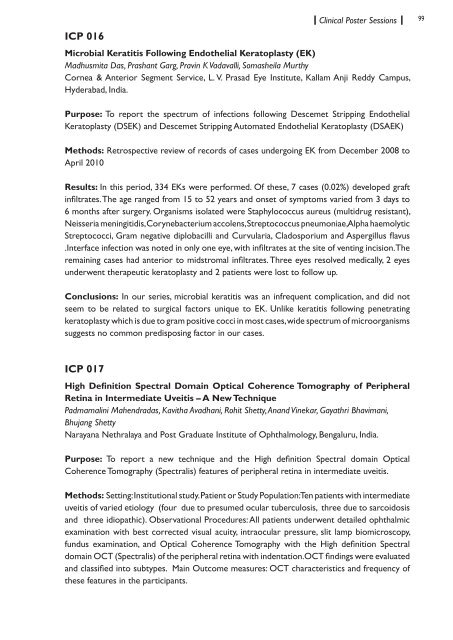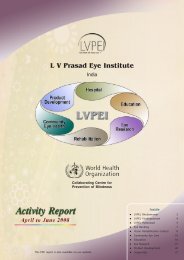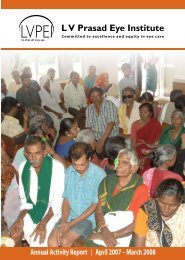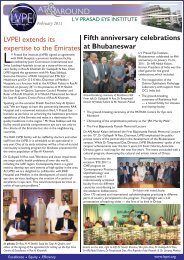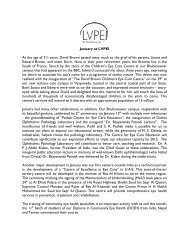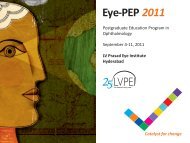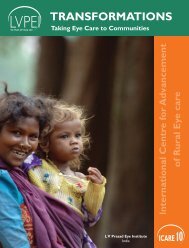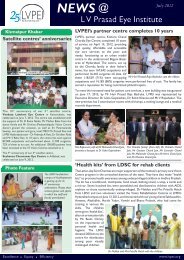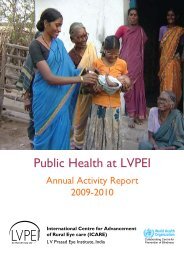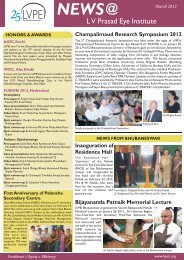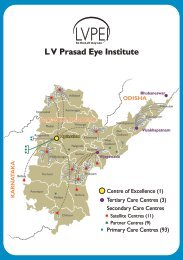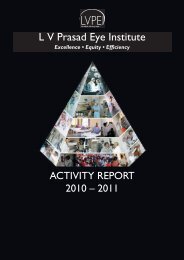IERG Abstracrt Book.indd - LV Prasad Eye Institute
IERG Abstracrt Book.indd - LV Prasad Eye Institute
IERG Abstracrt Book.indd - LV Prasad Eye Institute
Create successful ePaper yourself
Turn your PDF publications into a flip-book with our unique Google optimized e-Paper software.
ICP 016Clinical Poster SessionsMicrobial Keratitis Following Endothelial Keratoplasty (EK)Madhusmita Das, Prashant Garg, Pravin K Vadavalli, Somasheila MurthyCornea & Anterior Segment Service, L. V. <strong>Prasad</strong> <strong>Eye</strong> <strong>Institute</strong>, Kallam Anji Reddy Campus,Hyderabad, India.99Purpose: To report the spectrum of infections following Descemet Stripping EndothelialKeratoplasty (DSEK) and Descemet Stripping Automated Endothelial Keratoplasty (DSAEK)Methods: Retrospective review of records of cases undergoing EK from December 2008 toApril 2010Results: In this period, 334 EKs were performed. Of these, 7 cases (0.02%) developed graftinfiltrates. The age ranged from 15 to 52 years and onset of symptoms varied from 3 days to6 months after surgery. Organisms isolated were Staphylococcus aureus (multidrug resistant),Neisseria meningitidis, Corynebacterium accolens, Streptococcus pneumoniae, Alpha haemolyticStreptococci, Gram negative diplobacilli and Curvularia, Cladosporium and Aspergillus flavus.Interface infection was noted in only one eye, with infiltrates at the site of venting incision. Theremaining cases had anterior to midstromal infiltrates. Three eyes resolved medically, 2 eyesunderwent therapeutic keratoplasty and 2 patients were lost to follow up.Conclusions: In our series, microbial keratitis was an infrequent complication, and did notseem to be related to surgical factors unique to EK. Unlike keratitis following penetratingkeratoplasty which is due to gram positive cocci in most cases, wide spectrum of microorganismssuggests no common predisposing factor in our cases.ICP 017High Definition Spectral Domain Optical Coherence Tomography of PeripheralRetina in Intermediate Uveitis – A New TechniquePadmamalini Mahendradas, Kavitha Avadhani, Rohit Shetty, Anand Vinekar, Gayathri Bhavimani,Bhujang ShettyNarayana Nethralaya and Post Graduate <strong>Institute</strong> of Ophthalmology, Bengaluru, India.Purpose: To report a new technique and the High definition Spectral domain OpticalCoherence Tomography (Spectralis) features of peripheral retina in intermediate uveitis.Methods: Setting: Institutional study. Patient or Study Population: Ten patients with intermediateuveitis of varied etiology (four due to presumed ocular tuberculosis, three due to sarcoidosisand three idiopathic). Observational Procedures: All patients underwent detailed ophthalmicexamination with best corrected visual acuity, intraocular pressure, slit lamp biomicroscopy,fundus examination, and Optical Coherence Tomography with the High definition Spectraldomain OCT (Spectralis) of the peripheral retina with indentation.OCT findings were evaluatedand classified into subtypes. Main Outcome measures: OCT characteristics and frequency ofthese features in the participants.


